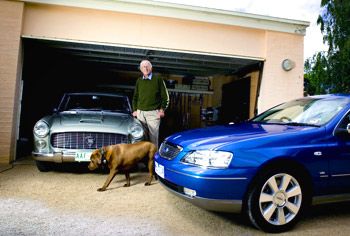 |
|
Australian Government cabinet papers for
1978, just released by the National Archives
of Australia, have revealed a bizarre
proposal that was tabled by Alfa Romeo to
trade ‘cars for cows’. |
|
|
|
 |
|
Then-Prime
Minister Malcolm Fraser had a passion for Italian cars, in
particular Lancias. Falling in love with an Aurelia whilst
studying at Oxford University in the 1950s, Fraser has
previously owned a string of the Turinese marque’s output; currently
he owns a 1966 Flaminia 2.8
berlina. Photo: Wheels. |
|
|
|
Australian Government cabinet papers for 1978,
just released by
the National Archives of Australia, have revealed a bizarre proposal by Alfa
Romeo to trade ‘cars for cows’. The deal would have involved buying 7000 tonnes
of beef and beef offal, in exchange for permission to sell 2000 cars – the
amount calculated as equivalent in value to the meat – over and above their
allocation.
Until 1988,
Australian car imports were restricted by a volume import
quota. All imports were heavily taxed with a tariff of 57.5
per cent, but importers who went over their allocation faced
a tariff of 100 per cent on any imports above the quota. Increases in quotas were also expensive and difficult to
secure, with every importer fighting for a highly limited
number of licences.
The deal was
proposed by the then-state-owned Alfa Romeo as an
imaginative way to bypass strict EEC trade barriers, which
maintained high barriers against the importation of
Australian primary products. In his submission to cabinet,
the minister for special trade representations, Victor
Garland, said the proposal came from the Italian embassy in
Canberra, with Alfa Romeo in Italy subsequently confirming
it was prepared to purchase Australian beef to be served in
Italian factory canteens.
Alfa’s parent
company, the state-owned Institute for Industrial
Reconstruction (IRR), would work through an Italian importer
with access to part of Italy’s share of the GATT (General
Agreement on Tariffs and Trade) levy-free quota. The
importer usually sourced beef in Argentina, but IRR
determined that it could exert its influence as a large
customer for it to buy Australian. The proposal was
envisaged as a one-off deal, but did not rule out “the
possibility of something beyond that”.
Garland said the
GATT system worked against Australia, which made negligible
exports to EEC nations, and hence, had no established
connections with meat importers. He said the proposal could
present an opportunity to break into the continental
community market for significant beef sales. However, he
had reservations about Australia becoming involved in the
business of trading car quotas, and was worried about
whether such an arrangement could be confined to the EEC.
Of concern was
whether other big buyers of Australian beef, such as the
USSR or even Japan, would be stimulated into seeking
enlarged car import quotas. The Industry Department also
noted that allocating an additional quota to Alfa Romeo
would mean taking it away from other European car makers –
it notably feared that BMW and Porsche may close dealerships
if this was to happen. Mr Garland
recommended that cabinet endorse further investigations, but
in the event, the suggestion was deferred for further
consideration; the proposal was eventually quietly dropped.
Then-Prime
Minister Malcolm Fraser had a passion for Italian cars, in
particular Lancias. Falling in love with an Aurelia whilst
studying at Oxford University in the 1950s, Fraser has
previously owned a string of the Turinese marque’s output,
including a Flaminia Zagato Super Sport, a Fulvia 1.6 HF, a
Flavia 2000 sedan and, currently, a 1966 Flaminia 2.8
berlina, plus an Alfa 164 for wife Tamie.
by Shant
Fabricatorian
Additional
material: The Australian / >
Cabinet Paper
|